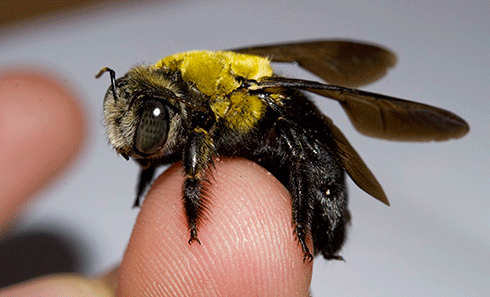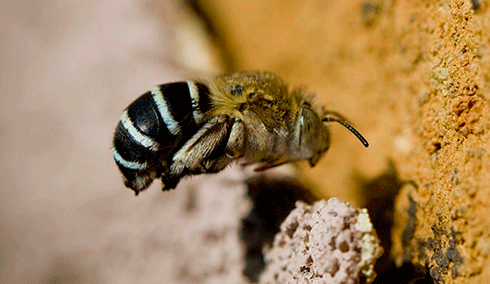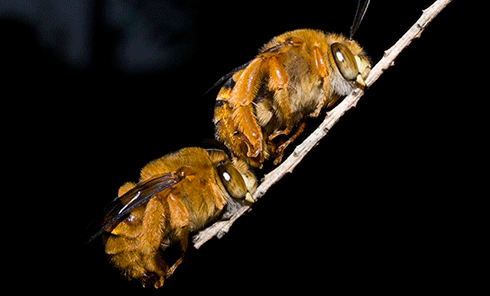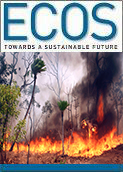
|
Published: 20 October 2014
If nature is the ultimate supermarket, who is looking after its supply chain?
Insects pollinate over 35 per cent of the food we eat or feed to livestock – like fruit, vegetables, oilseeds, legumes and fodder. While bees didn’t set out to fertilise food crops for the good of humankind, their urge to collect pollen and nectar for the good of the hive, by a stroke of luck, has provided us with an ‘ecosystem service’ that’s become indispensible to our way of life.
Bee pollination is one of myriad ecosystem services that humans, knowingly or otherwise, derive from nature. Others include food, fresh water, fibre, the generation of oxygen and regulation of greenhouse gases, seed dispersal and recycling of organic matter and nutrients.
Ecologists have defined ecosystem services as ‘the benefits provided to humans through the transformations of resources (or environmental assets, including land, water, vegetation and atmosphere) into a flow of essential goods and services e.g. clean air, water, and food’.
But does the world at large understand the extent of Earth’s ecosystem services and the benefits we receive from them – especially as the type of services ‘delivered’ by nature will shift as the environment and climate change? And could we restore degraded services in future, such as the pollination currently carried out by bees and other animals?
Finding answers to such questions is the task taken up by a team of scientists working within the Intergovernmental Platform on Biodiversity & Ecosystem Services (IPBES).
Like the more widely recognised Intergovernmental Panel on Climate Change (IPCC), the IPBES is an independent inter-governmental body set up to bridge the science-policy interface across UN member nations – in this case, for biodiversity, ecosystem services, conservation, and sustainable development.
One of the scientists participating in the IPBES task is Dr Saul Cunningham from CSIRO. For more than a decade, he has worked with a team of international researchers on pollination services provided by bees – both native and honey bees – in relation to crop productivity.
More recently, he has been involved in writing the first draft of the IPBES assessment on pollination services. The authors are aiming for the final assessment to be available in around 18 months – an ambitious time frame for a large collaborative report, but perhaps a crucial one given the sense of urgency around the rapid decline of ecosystem functions worldwide.
Saul feels we have much to learn yet about pollination services. ‘We know that different crops in different places will have different needs – and this kind of detailed place-by-place information is not yet available.
‘We are only at the beginning of understanding whether actions to support pollinators (like ecological restoration activities) are really working, and therefore what the best actions for the future will be.’
Millennium assessment first big step
The concept of ‘ecosystem services’ was at the heart of the UN’s Millennium Ecosystem Assessment, written between 2001 and 2005. In this process, more than 1360 experts assessed the world’s ecosystems and the services they provide to sustain humanity.
IPBES builds on this work, with an explicit aim to strengthen relationships between the scientific community and governments, the private sector and the community at large.
Pollinators were chosen as the first ecosystem service to be assessed through the IPBES assessment because of their contribution to human food security. Bees are also well-known to most people on the planet and well-studied worldwide – an important consideration, as the assessments led by IPBES use existing bodies of knowledge rather than funding new research.
Another CSIRO scientist, Dr Matthew Colloff, says the more we know about ecosystems, the more we realise how much we benefit from them. And the more we know about how we benefit from ecosystems, the more we are likely to value them.
He points out that information can change land management practices. In one research project he undertook on South Australian citrus orchards, Matthew demonstrated the possibility of growers modifying their practices once they understood how an ecosystem service functions.
In his study, some orchards were overrun by Kelly’s citrus thrips (an important insect pest) while others were not. The thrips-free orchards had dense ground cover of grasses and herbaceous plants, which provided habitat for a diversity of mites that preyed on the thrips larvae. Once they know of this service – pest control for orchards afforded by mites in ground cover – growers can integrate this knowledge with their practice, benefit from natural pest control, cut their insecticide use and save substantially on production costs.
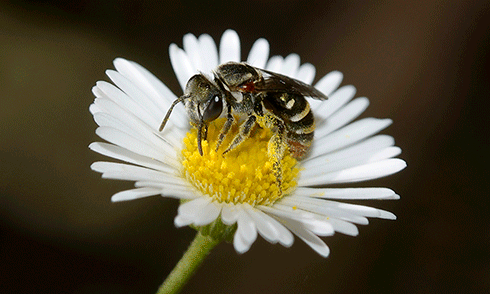
|
|
The Australian native bee, Lipotriches (Austronomia) australica. Credit:
Dr Tobias Smith
|
What ‘service’ do pollinators provide?
Agricultural insect pollination services are as variable as our diet. Global staples such as wheat are wind pollinated, while others such as rice are propagated vegetatively, without the need for pollination.
Only 35 per cent of the food we eat depends on insect pollination.
Being portable (via transportable hive ‘homes’) and domesticated, it’s not hard to see why European honey bees offer a convenient, secure option for crop pollination. But although they are the go-to pollinators for agriculture, honey bees in fact supplement the pollination services already provided by wild insects, according to recent research. This research showed that, even when honey bees were present, fruit set (the progression from fertilised flower to fruit) in crops was reduced where there was a lower abundance and diversity of wild pollinators.
As Saul Cunningham points out, it’s not a case of honey bees versus native bees, but a combination of both that provides the best yields, so encouraging diverse and abundant wild insect populations leverages the valuable ecosystem service native pollinators provide.
Dr Tobias Smith, an ecologist at the University of Queensland studying bee communities in rural landscapes in north Queensland and South Australia, says there are about 2000 bee species native to Australia and an estimated 30,000 different species of flies. His research in northern Queensland highlights how much we have to learn about native pollinators.
He says that pollinators, including bees, flies, butterflies and birds, ‘play an integral role in the functioning of our ecosystems and yet we know little about their communities in the Australian tropics, or how these communities respond to landscape change.
‘We need to better understand how human practices are affecting communities that are directly involved in vital ecosystem processes, such as pollinator communities, so that we can ensure that these ecosystems continue to function into the future.’
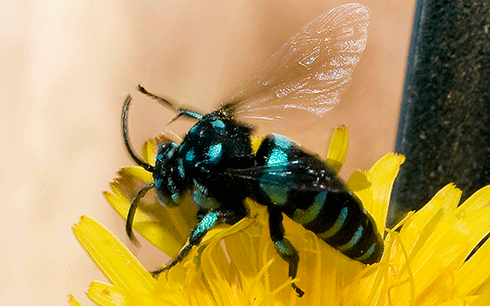
|
|
The parasitic neon cuckoo bee. Credit:
Dr Tobias Smith
|
Can we restore and manage an ecosystem service?
Although the relationship between biodiversity and ecosystem functioning is still poorly understood, scientists generally believe an increase in biodiversity will provide an increase in ecosystem function (and therefore ecosystem services). Research has shown that levels of biodiversity and ecosystem services remain higher in undisturbed areas than in ecologically restored areas.
Bees are adapted to open environments so they do quite well in agricultural landscapes – but they still need a level of plant diversity, according to Saul Cunningham. He says a landscape that is managed to provide diverse pollination would include native vegetation patches throughout to provide habitat for wild pollinators.
Indeed, an international study into wild insect pollination published last year in Science found that the insect populations benefited from:
-
conservation or restoration of natural or semi-natural areas
-
promotion of a ‘patchwork’ landscape
-
addition of diverse floral and nesting resources, and
-
consideration of pollinator safety when applying pesticides.
Importantly, the authors concluded that while these polices have associated costs, they will enhance other ecosystem services such as soil erosion mitigation, improved pest control, increased nutrient cycling and water use efficiency.
‘All ecosystem functions are interdependent,’ notes Matthew Colloff. ’One of my major concerns around how we use ecosystem services and adopt polices is how we conceptualise the importance of different ecosystem functions.
‘There is a danger that when you prioritise “provisioning services” or what we use – for example food, energy and fuel – then what about the support services that underpin these? You can’t disaggregate these things; all ecosystem components depend on each other.
‘We need to be aware of the implications of trading off some services for others and what we might compromise in the process.’
|
They may not be counted among the world’s most charismatic creatures, but bees and other pollinators have developed some fascinating traits as a result of their co-evolutionary relationship with plants. |
The Australian native blue-banded bee buzz-pollinates by holding onto the flower and buzzing vigorously; this vibrates their antlers and dislodges any pollen stuck to them. |
The fig wasp mates inside the fig itself. The female then flies into another fig to lay her eggs, pollinating that fig. The fig plant detects the wasp eggs and surrounds them with plant tissue so the wasp larvae will have food when they hatch. |
There are 25 Australia species of’ teddy bear bees’. They live in shallow nests in soil. |
Native Australian bees are only 3–5 mm in size, black and stingless. |
Some orchids lure pollinating wasps by emitting a chemical mimicking a pheromone emitted by a female wasp. Males then mate with the flower, pollinating them in the process. |
Around 65 per cent of all flowering plants are pollinated by insects. |


